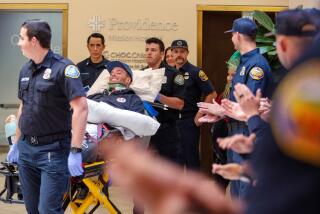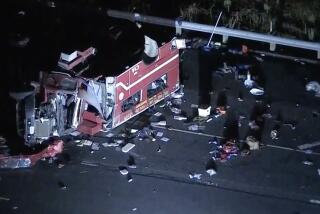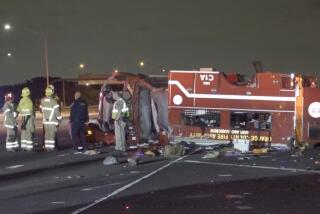COUNTYWIDE : Casualty Drill Tests Area Crews
Seated inside an overturned school bus with splotches of fake blood on her face, Jenny Quilico, 9, waited for the fire department to set a nearby car ablaze so the disaster could begin.
Moments later, Jenny, who was acting the part of an injured accident victim in a massive casualty drill, began to yell for help. Crying and moaning all around her, about 80 other volunteers also displaying mock injuries pleaded for medical aid as the test of central Orange County’s lifesaving services got underway.
“I think it’s fun,” Jenny said later, holding up her arm which was made up to look broken. She said the drill made her feel safe because it would improve the treatment of real accident victims in the future. “I don’t want to get in an accident and have a fireman have no experience,” she said.
The realistic test involved about 100 firefighters, police, and paramedics from Santa Ana, Westminster, Fountain Valley, Huntington Beach and Costa Mesa and Marine search-and-rescue crew members from El Toro. Ambulances and helicopters transported the mock victims to several local hospitals which also participated.
The event began at 9:05 a.m. when police responded to a report of a chain-reaction accident involving a bus and five cars on Rancho Road between Bolsa Chica Road and Westminster Boulevard in Westminster. The first motorcycle police officer on the scene found a school bus on its side, a car engulfed in flames, another car thrown into the bottom of a nearby wash and several dozen injured victims.
The officer determined that the number of casualties would quickly overwhelm local fire, police and hospital resources. He called for a massive infusion of emergency help from other cities, which eventually included 72 fire trucks, paramedic units, police cars and ambulances.
Firefighters used hydraulic pinchers and other tools to cut through the school bus roof to free trapped passengers. They scrambled to determine which of the injured required the most immediate treatment, giving victims colored tags describing the seriousness of their wounds. Nearby, Marine search-and-rescue crews descended from a helicopter that hovered above the car that had fallen into the wash.
The drill attracted curious residents from nearby homes who quickly joined the crowd of 250 public officials and observers seated on bleachers for the event.
Westminster Battalion Capt. Glen Hines emphasized that in a real disaster, not everyone would get immediate treatment. Officials on the scene must know how many victims each nearby hospital can handle and send only the most serious cases first.
“If we’re dealing with one person, it’s a lot different than when you have 100. The goal is to save as many lives as possible, and it may sound heartless, but sometimes it’s better to write off one person, to save three others,” he said.
Craig Campbell, spokesman for the Westminster Fire Department, which hosted the event, called the drill a success, despite a communications problem that delayed getting ambulances to the correct hospitals by as much as four minutes. He said even short delays in a real emergency are unacceptable because trauma victims who do not get medical attention within an hour of their injury are less likely to survive.
Still, he added, “in any type of drill you’re going to make mistakes. We hope that we’ll make them during the drill and we hope that when a real disaster comes, we’ll do it right. That’s the whole purpose of this.”
More to Read
Sign up for Essential California
The most important California stories and recommendations in your inbox every morning.
You may occasionally receive promotional content from the Los Angeles Times.










